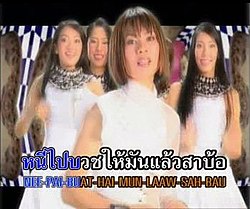Mor lam
Mor lam (Thai/Isan หมอลำ) is an ancient Lao song form of Laos and Isan (Northeastern Thailand), where the majority of ethnic Lao live. Mor lam means expert song, or expert singer, referring to the music or artist respectively. In Laos, the music is known as lao lam.
Traditionally mor lam was extemporaneous singing accompanied by the khene, a free reed mouth organ, but the modern form is most often composed and uses electrified instruments. Musically it is characterised by quick tempi and rapid delivery.
As well as the usual theme of unrequited love, mor lam reflects the difficulties of live in rural Isan and Laos, leavened with wry humour. The music has gained a profile outside its native regions thanks to the spread of migrant workers, for whom it remains an important cultural link with home.
History
Some scholars have proposed that the origin of the form was in shamanistic chants, but its similarities to Central Thai lam tad may indicate it is a formalized courting rite. One of the most popular styles of traditional mor lam was a vocal "battle" between a man and a woman, who would alternately improvise songs teasing and mocking one another (cf. the Rap Olympics). Lam in Laos is more traditional than in Thailand, where it has evolved more under greater exposure to Central Thai luk thung and to western pop music.
Characteristics
Mor lam songs are most often in the Isan language, but with titles in Thai. The music is characterized by a great tonal range and sudden changes to prestissimo tempo.
Audio sample (Ogg format) from Rooplaw Lai Mia (Handsome Man With Many Wives) by Jintara
As in most popular musics, unrequited love is a prominent theme in mor lam. However, this is laced with a considerable amount of humour, as in song titles such as Rock Salaeng's I Want to Get a Foreign Husband, and Jintara's Jeans that Belong to the Past. Many songs feature a loyal boy or girl who stays at home in Isan, while his or her partner works as a migrant labourer in Bangkok and finds a new, richer lover.
There are four main sections to a mor lam song, although not all appear in every song:
- A talk section, consisting of words spoken to a slow accompaniment; this is normally omitted in recordings.
- The gern, a slow, sung introduction, generally accompanied by the khene, and often including the words o la naw ("oh fate") (sample).
- The lam, a rap-style chorus (sample).
- The plaeng, or verse (sample).
The samples are in Ogg format, and are taken from Peemai Jaisalai by Dokfa Petcharaphupan.
Performance
Before World War II, performance of mor lam was a largely local affair, confined to events such as festivals in Isan and Laos. However as Isan people began to migrate to the rest of the country, the music spread with them. In 1946 a performance took place at the Rajdamnoen Boxing Stadium which was first advertised by sound trucks. Migrant Lao, upon hearing their music, followed the trucks to the stadium where nearly three thousand people heard the performance.
Even then, the number of migrant workers from Isan remained fairly small, and mor lam was paid little attention by the outside world. This began to change in the late 1970s and early 1980s, when more and more people left Isan in search of work. Mor lam performers began to appear on television, and the genre soon gained a national profile.
Live performances are often large-scale events, involving several singers, a dance troupe and comedians. The dancers (or hang khreuang) in particular often wear spectacular costumes, while the singers may go through several costume changes in the course of an evening.
Recordings

As few mor lam artists write all their own material, many of them are extremely prolific, producing around four albums each year. Major singers release their recordings on audio tape, CD and VCD formats. The albums may take their names from a title track, but others are simply given a series number.
Mor lam VCDs can also often be used for karaoke. A typical VCD song video consists of a performance and a film intercut, although it may consist only of one of these elements. In the performance, the singer performs the song in front of a group of dancers, normally female. There may be a number of these recordings in different costumes, and costumes may be modern or traditional dress. The singer often wears the same costume in different videos on the same album. The performance may be outdoors or in a studio; studio performances are often given a psychedelic animated backdrop. The film depicts the subject matter of the song. In some cases, the lead role in the film is played by the singer.
Some of the most popular current artists are Banyen Rakgan, Chalermphol Malaikham, Jintara Poonlarp and Siriporn Ampaipong. 2001 saw the release of the first album by Dutch singer Christy Gibson.
Instruments
The traditional instruments of mor lam are:
- the khene: a mouth pipe organ, consisting of around 14 bamboo tubes above a mouthpiece;
- the phin: a lute, normally three-stringed;
- the ching: small bells;
- the sor: a bowed string instrument;
- panpipes; and
- hand drums.
